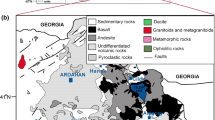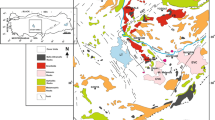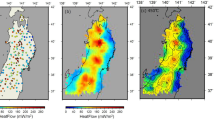Abstract
In this study, curie point depth (CPD), heat flow, geothermal gradient, and radiogenic heat production maps of the Cappadocian region in central Anatolia are presented to reveal the thermal structure from the aeromagnetic data. The large, circular pattern in these maps matches with previously determined shallow (2 km in average) depression. Estimated CPDs in this depression filled with loose volcano-clastics and ignimbrite sheets of continental Neogene units vary from 7 to 12 km, while the geothermal gradient increases from 50 to 68 °C/km. Heat flows were calculated using two different conductivity coefficients of 2.3 and 2.7 Wm−1 K−1. The radiogenic heat production was also obtained between 0.45 and 0.70 μW m−3 in this area. Heat-flow maps were compared with the previous, regional heat-flow map of Turkey and significant differences were observed. In contrast to linear heat-flow increment through the northeast in the previous map in the literature, produced maps in this study include a large, caldera-like circular depression between Nevsehir, Aksaray, Nigde, and Yesilhisar cities indicating high geothermal gradient and higher heat-flow values. In addition, active deformation is evident with young magmatism in the Neogene and Quaternary times and a large volcanic cover on the surface. Boundaries of volcanic eruption centers and buried large intrusions are surrounded with the maxspots of the horizontal gradients of magnetic anomalies. Analytic signal (AS) map pointing-out exact locations of causative bodies is also presented in this study. Circular region in the combined map of AS and maxspots apparently indicates a possible caldera.










Similar content being viewed by others
References
Artemieva, I. M., & Money, W. D. (2001). Thermal thickness and evolution of Precambrian lithosphere. Journal of Geophysical Research, 106, 16387–16414.
Ates, A., Bilim, F., & Buyuksarac, A. (2005). Curie point depth investigation of Central Anatolia, Turkey. Pure and Applied Geophysics, 162, 357–371.
Aydar, E., & Gourgaud, A. (1998). The geology of Mount Hasan stratovolcano, central Anatolia, Turkey. Journal of Volcanology and Geothermal Research, 85, 129–152.
Aydemir, A. (2008). Hydrocarbon potential of the Tuzgolu (Salt Lake) Basin, Central Anatolia, Turkey: a comparison of geophysical investigation results with the geochemical data. Journal of Petroleum Science and Engineering, 61, 33–47.
Aydemir, A. (2009). Tectonic investigation of central Anatolia., Turkey, using geophysical data. Journal of Applied Geophysics, 68, 321–334.
Aydemir, A., & Ates, A. (2005). Preliminary evaluation of Central Anatolian basins in Turkey using the gravity and magnetic data. Journal of the Balkan Geophysical Society, 8, 7–19.
Aydemir, A., & Ates, A. (2006). Structural interpretation of the Tuzgolu and Haymana Basins, Central Anatolia, Turkey, using seismic, gravity and aeromagnetic data. Earth, Planets and Space, 58, 951–961.
Ayhan, A.K., & Papak, I. (1988). Aksaray-Taspinar-Altınhisar-Ciftlik-Delihebil (Nigde) civarinin jeolojisi. MTA Report No. 8315 (unpublished).
Baldwin, R. T., & Langel, R. (1993). Tables and maps of the DGRF 1985 and IGRF 1990, international union of geodesy and geophysics association of geomagnetism and aeronomy. IAGA Bulletin, 54, 158.
Bas, H., Guner, Y., & Emre, O. (1986). Erciyes Dagi volkanitlerinin ozellikleri. Selcuk Universitesi. Mühendislik Mimarlık Fakültesi Dergisi, 1, 29–44.
Batum, I. (1978a). Nevsehir GB Golludag ve Acigol yoresi volkanitlerinin jeolojisi ve petrografisi. Hacettepe Yerbilimleri Dergisi, 3, 50–69.
Batum, I. (1978b). Golludag ve Acigol volkanitlerinin jeokimyasi ve petrolojisi. Hacettepe Yerbilimleri Dergisi, 3, 70–88.
Besang, C., Eckhardt, F. J., Harre, W., Kreuzer, H., & Muller, P. (1977). Radiometrische Altersbestimmungen an Neogenen Eruptivgsteinen der Turkei. Geologisches Jahrbuch, 25, 3–36.
Bigazzi, G., Yegingil, Z., Ercan, T., Oddone, M., & Ozdogan, M. (1993). Fission track dating obsidians of Central and Northern Anatolia. Bulletin of Volcanology, 55, 588–595.
Bilim, F., & Ates, A. (2003). Analytic Signal inferred from reduced to the pole data. Journal of the Balkan Geophysical Society, 6, 66–74.
Bilim, F., & Ates, A. (2005). Analitik Sinyal yontemlerinin manyetik model verileri uzerinde karsilastirilmasi. Istanbul niversitesi Mühendislik Fakültesi Yerbilimleri Dergisi, 18, 151–162. (in Turkish with English Abstract).
Bilim, F., Akay, T., Aydemir, A., & Kosaroglu, S. (2016). Curie point depth, heat flow and radiogenic heat production deduced from the spectral analysis of the aeromagnetic data for geothermal investigation on the Menderes Massif and the Aegean Region, western Turkey. Geothermics, 60, 44–57.
Bingol, E. (1974). 1:2500 000 olcekli Turkiye metamorfizma haritasi ve bazi metamorfik kusaklarin jeoteknik evrimi uzerine tartismalar. MTA Bulletin, 83, 178–184.
Blakely, R. J. (1996). Potential theory in gravity and magnetic applications. Cambridge: Cambridge University Press.
Buyuksarac, A., Jordanova, D., Ates, A., & Karloukovski, V. (2005). Interpretation of the Gravity and Magnetic anomalies of the Cappadocia Region, Central Turkey. Pure and Applied Geophysics, 162, 2197–2213.
Dolmaz, M. N., Hisarli, Z. M., Ustaomer, T., & Orbay, N. (2005a). Curie point depths based on spectrum analysis of the aeromagnetic data, West Anatolian Extensional Province, Turkey. Pure and Applied Geophysics, 162, 571–590.
Dolmaz, M. N., Ustaomer, T., Hisarli, Z. M., & Orbay, N. (2005b). Curie Point Depth variations to infer thermal structure of the crust at the African-Eurasian convergence zone, SW Turkey. Earth Planets Space, 57, 373–383.
Ekingen, A. (1982). Nevsehir kalderasinda jeofizik prospeksiyon sonuclari (p. 82). Turkiye Jeoloji Kurultayi: Abstract Book.
Froger, J. L., Lenat, J. F., Chrowicz, J., Le Pennec, J. L., Bourdier, J. L., Kose, O., et al. (1998). Hidden calderas evidenced by multisource geophysical data; example of Cappadocian Calderas, Central Anatolia. Journal of Volcanology and Geothermal Research, 185, 99–128.
Frost, B. R., & Shive, P. N. (1986). Magnetic mineralogy of the lower continental crust. Journal of Geophysical Research, 91, 6513–6521.
Hsieh, H. H., Chen, C. H., Lin, P. Y., & Yen, H. Y. (2014). Curie point depth from spectral analysis of magnetic data in Taiwan. Journal of Asian Earth Sciences, 90, 26–33.
Hunt, C.P., Moskowitz, B.M., & Banerjee, S.K. (1995). Magnetic properties of rocks and minerals. In: T.J. Ahrens (Ed.), Rock physics and phase relations: a handbook of physical constants (pp. 189–204). American Geophysical Union.
Ilkisik, M., Gurer, A., Tokgoz, T., & Kaya, C. (1997). Geoelectromagnetic and geothermic investigations in the Ihlara Valley Geothermal Field. Journal of volcanology and geothermal Research, 78, 297–308.
Innocenti, F., Mazzuoli, G., Pasquare, F., Radicati Di Brozolo, F., & Villari, L. (1975). The Neogene calcalkaline volcanism Central Anatolia: geochronological data on Kayseri-Nigde area. Geological Magazine, 112, 349–360.
Jaupart, C. (1986). On the average amount and vertical distribution of radioactivity in the continental crust. In J. Burrus (Ed.), Thermal modeling in sedimentary basins (pp. 33–47). Paris: Editions Technip.
Kosaroglu, S., Buyuksarac, A., & Aydemir, A. (2016). Modeling of shallow structures in the Cappadocia region using gravity and aeromagnetic anomalies. Journal of Asian Earth Sciences, 124, 214–226.
Lachenbruch, A. H. (1970). Crustal temperature and heat production: implication of the linear heat flow relationship. Journal of Geophysical Research, 75, 3291–3300.
Le Pennec, J. L., Bourdier, J. L., Froger, J. L., Temel, A., Camus, G., & Gourgaud, A. (1994). Neogene ignimbrites of the Nevsehir plateau (Central Turkey): stratigraphy distribution and source constraints. Journal of Volcanology and Geothermal Research, 63, 59–67.
MacLeod, I. N., Jones, K., & Dai, T. F. (1993). 3-D analytic signal in the interpretaiton of total magnetic field data at low magnetic latitudes. Exploration Geophysics, 24, 679–688.
Nabighian, M. N. (1972). The analytic signal of two-dimensional magnetic bodies with polygonal cross-section: its properties and use for automated anomaly interpretation. Geophysics, 37, 507–517.
Okubo, Y., Graf, R. J., Hansen, R. O., Ogawa, K., & Tsu, H. (1985). Cruie Point Depths of the Island of Kyushu and Surrounding Areas, Japan. Geophysics, 50, 481–494.
Okubo, Y., Tsu, H., & Ogawa, K. (1989). Estimation of Curie point and geothermal structure of island arcs of Japan. Tectonophysics, 159, 279–290.
Okubo, Y., Uchida, Y., Taniguchi, M., Miyakoshi, A., & Safanda, J. (2005). Statistical analysis for thermal data in the Japanese Islands. Physics of the Earth and Planetary Interiors, 152, 277–291.
Onal, K. M., Buyuksarac, A., Aydemir, A., & Ates, A. (2008). Investigation of the deep structure of the Sivas Basin with geophysical methods, Innereast Anatolia, Turkey. Tectonophysics, 460, 186–197.
Ortiz-Aleman, C., & Urrutia-Fucugauchi, J. (2010). Aeromagnetic anomaly modeling of central zone structure and magnetic sources in the Chicxulub crater. Physics of the Earth and Planetary Interiors, 179, 127–138.
Pasquare, G. (1968). Geology of the Cenozoic volcanic area of Central Anatolia. Atti Accad Naz Lincei, 9, 53–204.
Pasquare, G., Poli, S., Vezzoli, L., & Zanchi, A. (1988). Continental arc volcanism and tectonic setting in Central Anatolia, Turkey. Tectonophysics, 146, 217–230.
Piper, J. D. A., Gursoy, H., & Tatar, O. (2002). Palaeomagnetism and magnetic properties of the Cappadocian ignimbrite succession, central Turkey and Neogene tectonics of the Anatolian collage. Journal of Volcanology and Geothermal Research, 117, 237–262.
Piper, J. D. A., Kocbulut, F., Gursoy, H., Tatar, O., Viereck, L., Lepetit, P., et al. (2013). Palaeomagnetism of the Cappadocian Volcanic Succession, Central Turkey: major ignimbrite emplacement during two short (Miocene) episodes and Neogene tectonics of the Anatolian collage. Journal of Volcanology and Geothermal Research, 262, 47–67.
Platzman, E. S., Tapirdamaz, C., & Sanver, M. (1998). Neogene anticlockwise rotation of Central Anatolia (Turkey): preliminary palaeomagnetic and geochronological results. Tectonophysics, 299, 175–189.
Ross, H. E., Blakely, R. J., & Zoback, M. D. (2006). Testing the use of aeromagnetic data for the determination of Curie depth in California. Geophysics, 71, L51–L59.
Rozimant, K., Buyuksarac, A., & Bektas, O. (2009). Interpretation of magnetic anomalies and estimation of depth of magnetic crust in Slovakia. Pure and Applied Geophysics, 166, 471–484.
Saibi, H., Nishijima, J., Ehara, S., & Aboud, E. (2006). Integrated gradient interpretation techniques for 2-D and 3-D gravity data interpretation. Earth Planets Space, 58, 815–821.
Salem, A., Ravat, D., Gamey, T. J., & Ushijima, K. (2002). Analytic signal approach and its applicability in environmental magnetic investigations. Journal of Applied Geophysics, 49, 231–244.
Sassano, G. (1964). Acıgol bolgesinde Neojen ve Kuvaterner Volkanizmasi. MTA Report No. 6841, Ankara.
Schlinger, C. M. (1985). Magnetization of lower crust and interpretation of regional crust anomalies: example from Lofoten and Vesteralen, Norway. Journal of Geophysical Research, 90, 11484–11504.
Seymen, I. (1982). Kaman dolayinda Kirsehir Masifi’nin jeolojisi. TPAO Report No. 1836 (unpublished).
Spector, A., & Grant, F. S. (1970). Statistical models for interpretation aeromagnetic data. Geophysics, 35, 293–302.
Springer, M. (1999). Interpretation of heat-flow density in the Central Andes. Tectonophysics, 306, 377–395.
Stampolidis, A., & Tsokas, G. N. (2002). Curie point depths of Macedonia and Thrace, N. Greece. Pure and Applied Geophysics, 159, 2659–2671.
Tanaka, A., Okubo, Y., & Matsubayashi, O. (1999). Curie point depth based on spectrum analysis of the magnetic anomaly data in east and southeast Asia. Tectonophysics, 306, 461–470.
Temel, A., Gundogdu, M. N., Gourgaud, A., & Le Pennec, J. L. (1998). Ignimbrites of Cappadocia (Central Anatolia, Turkey): petrology and Geochemistry. Journal of Volcanology and Geothermal Research, 85, 447–471.
Tezcan, A. K., & Turgay, M. I. (1987). Heat flow density distribution in turkey. Ankara: Publ. MTA.
Toprak, V. (1998). Vent distribution and its relation to regional tectonics, Cappadocian volcanics, Turkey. Journal of Volcanology and Geothermal Research, 85, 55–67.
Tsokas, G. N., Hansen, R. O., & Fytikas, M. (1998). Curie point depth of the island of Crete (Greece). Pure and Applied Geophysics, 152, 747–757.
Turcotte, D. L., & Schubert, G. (1982). Geodynamics: Applications of continuum physics to geological problems. New York: Wiley.
Acknowledgements
The authors thank the General Directorate of the Mineral Research and Exploration (MTA) of Turkey for the provision of gravity and aeromagnetic data that were obtained for a TUBITAK Project (Project No: YDABCAG-118).
Author information
Authors and Affiliations
Corresponding author
Rights and permissions
About this article
Cite this article
Bilim, F., Kosaroglu, S., Aydemir, A. et al. Thermal Investigation in the Cappadocia Region, Central Anatolia-Turkey, Analyzing Curie Point Depth, Geothermal Gradient, and Heat-Flow Maps from the Aeromagnetic Data. Pure Appl. Geophys. 174, 4445–4458 (2017). https://doi.org/10.1007/s00024-017-1666-z
Received:
Revised:
Accepted:
Published:
Issue Date:
DOI: https://doi.org/10.1007/s00024-017-1666-z




